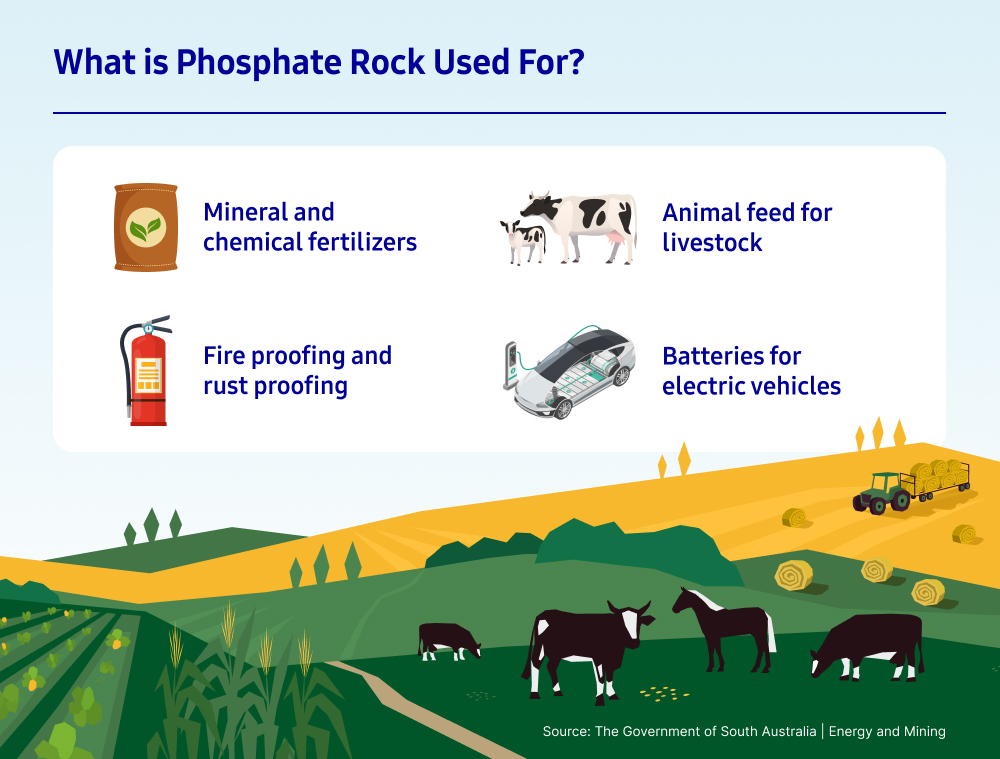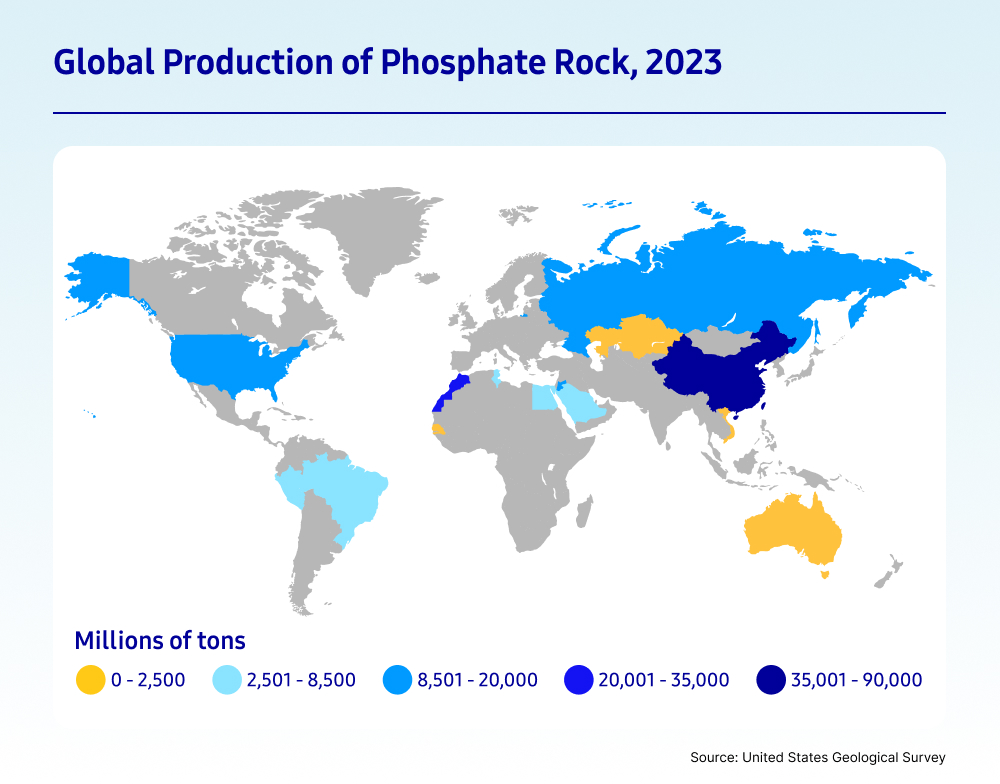Discover more about the crucial mineral phosphate rock and how it is used to make everything from fertilizers to electric vehicle batteries. Gain insight into where the world’s phosphate comes from and predictions for the future of the phosphate rock market and global demand.

Did you know that the average human body contains 0.62 kg of phosphorus, a vital mineral that is also found in phosphate rocks. According to the United States Geological Survey (USGS), the world contains more than 300 billion tons of phosphate rock. The phosphorus found in phosphate rocks is used to make fertilizer, which ensures productive and healthy crop yields globally. While 90% of mined phosphate rock is used to make chemical fertilizers, it is also used in animal feed for livestock, beverages, pharmaceuticals, household cleaning products, and some EV batteries.
Samsung C&T Trading and Investment (T&I) Group is involved in trading phosphate rock in Asia and around the world and is striving to expand its business opportunities for future growth.
What is Phosphate Rock?
Phosphate rock is a key raw material that is mined globally. The phosphorus found in phosphate rocks is one of the key nutrients that plants need to grow along with nitrogen and potassium. These nutrients are crucial for ensuring that soil can thrive and produce productive crop yields.
Making Fertilizer from Phosphate Rock
Phosphate rock is mined and treated with sulfuric acid, resulting in a chemical called phosphoric acid. Phosphoric acid is then turned into a variety of phosphate fertilizers (P2O5) in a concentrated form or by being mixed with ammonia.

Applications of Phosphate Rock
According to the Government of South Australia, around 90% of phosphate rock is mined to make chemical fertilizers. As well as being used to make fertilizer, phosphate rock is also an important ingredient in animal feeds, an additive in beverages and pharmaceuticals, and household cleaning items such as detergents and soaps. Industrial applications of phosphate rock include chemicals used to treat water, fire proofing, and rust proofing.
Electric Vehicle Batteries
Phosphate rock is also becoming more widely used to make lithium iron phosphate (LFP) batteries used in electric vehicles (EVs). With a global shift toward electrification, there has been an increase in rapid technology developments of EV batteries. LFP batteries are now being produced as an alternative to conventional lithium-ion batteries due to higher energy density, lifespan, and safety, and reduced cost. Phosphate rock is used for manufacturing the lithium-iron-phosphate battery cathode active material. According to the International Energy Agency (IEA), LFP batteries accounted for just under 30% of the total battery market in 2022.
Where is Phosphate Rock Found?
Phosphate rock mines are found all around the world, with a global reserve volume of 74 billion metric tons. The largest volume of phosphate rock is in reserves located in Morocco. Reserves in Morocco and Western Sahara alone account for approximately 50 billion metric tons, or 67.57%, of global phosphate rock reserves.
According to the USGS, production of phosphate rock globally is projected to increase to 69.1 million tons by 2027 from 63.6 million tons in 2023. The largest phosphate rock producers globally in 2023 were China, Morocco, United States, Russia, Jordan, and Saudi Arabia. The USGS stated that there are expected production expansions to be completed in 2026 in Brazil, Kazakhstan, Mexico, followed by expansions in Canada and Australia after 2027.

Market Outlook for Phosphate Rock
The phosphate rock market size was valued at an estimated $23.32 billion USD in 2022. The market size is projected to grow to $32.89 billion USD by 2032 at a compound annual growth rate (CAGR) of 3.4% from 2023 to 2032.
USGS estimates that the global consumption of phosphate rock used in fertilizers was 45.7 million tons in 2023 compared to 43.8 million tons in 2022. This growth in consumption globally highlights the growing demand for phosphate rock in the agriculture sector.
Currently, there is no known substitute for phosphate, making it a finite resource. This poses a risk to future demand for phosphate rock, with experts predicting varying estimates for when we will reach ‘peak phosphate.’ The IEA also states that rising EV battery demand could conflict with agricultural phosphate demand in the future.

Phosphate Rock Demand by Region
The Asia-Pacific region holds the largest share of the phosphate market globally and is expected to continue to drive growth. Growth in the Asia-Pacific region is driven by factors including the growing demand for fertilizers among growing populations and increased government subsidies. India is the largest importer of phosphate rock globally and brings in nearly 10 million tonnes per year.
The European market is expected to see fast market growth in the phosphate rock market with a trend focusing on establishing new ways to recycle phosphorus. For example, the company PhosCycle has developed technology that recycles expired fire extinguisher powder to create phosphate fertilizer.
The rising demand for fertilizers in countries such as Saudi Arabia, Brazil, and Morocco will drive growth across South America, the Middle East, and Africa. While demand for increased agricultural productivity in the Sub-Saharan African region will fuel demand.
Building Blocks for the Future
It is amazing what we can create with materials like phosphate rock. Transforming a material from a rock into the vital fertilizers that help grow our food around the world and help power the batteries in vehicles of the future. If you enjoyed this article, you may also enjoy our recent deep dive into fertilizers which can be found here: Market Inside and Beyond: The Future of the Fertilizers that Feed Our World.








